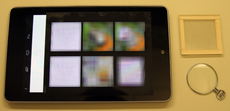Doug Lanman's prototype light field viewer
Doug Lanman's prototype light field viewer is a prototype light field viewer created by Doug Lanman. It uses a microlens array and printed backlit LVT film.[1]
It is made using a backlight from a cell phone panel, which is essentially a 1 millimeter thick light box. There is a film that is about 4 by 4 centimeters that is layered over the backlight. The film simulates a 3000 pixel per inch display.[1]
It was presented at SVVR #5.[1]
It was packaged and sent to people. The kit contained an LVT film and a plano-convex microlens array with an affixed plastic spacer.[2]
A light valve technology (LVT) film recorder was used to develop 3.75×3.75 cm color transparencies at 120 pixels per mm (ppmm). The transparencies were backlit to emulate high-resolution microdisplays. The magnifier array comprised a Fresnel Technologies #630 rectangular plano-convex microlens sheet, with lens focal length f = 3.3 mm and lens width wl = 1.0 mm. The microlenses were oriented with the planar surface facing the viewer. The separation between the microlens array and the transparency was manually adjusted to form a virtual image at a distance of about 1.0 m (as assessed by a focused camera). For an eye relief of = 2.5 cm, the equations in Section 3 of Near-Eye Light Field Displays provide the following estimates of design parameters: spatial resolution Np = 534×534 pixels, field of view α= 67×67 degrees, and eye box width = 7.6×7.6 mm. The depth of field extends over the interval 23.2 to ∞ cm.[3]
References[edit]
- ↑ Jump up to: 1.0 1.1 1.2 "SVVR #5 Presentation: Douglas Lanman from NVIDIA, Near-Eye Light Displays". 2024-03-06. https://www.youtube.com/watch?v=vNQ2NfbYjIc.
- ↑ https://research.nvidia.com/sites/default/files/pubs/2013-11_Near-Eye-Light-Field/NVIDIA-NELD-Physical.pdf
- ↑ "Error: no
|title=specified when using {{Cite web}}". https://research.nvidia.com/sites/default/files/pubs/2013-11_Near-Eye-Light-Field/NVIDIA-NELD.pdf.
